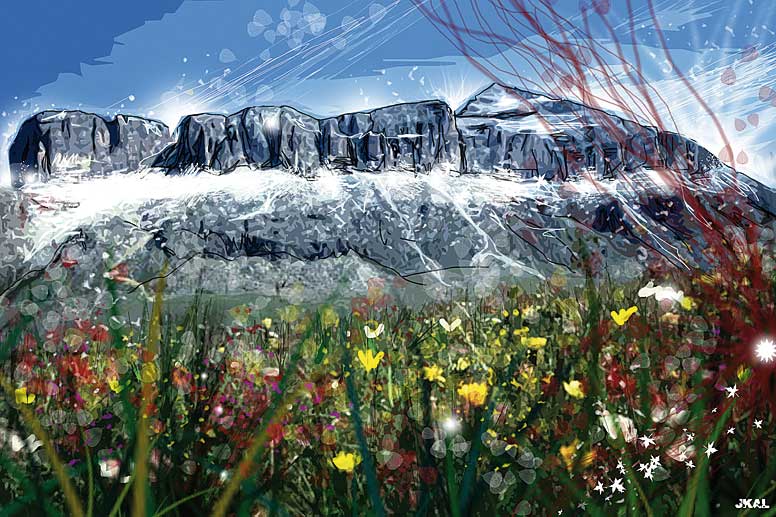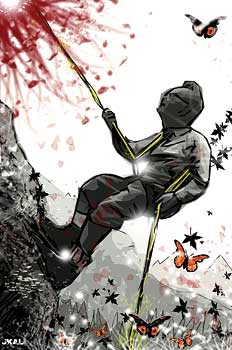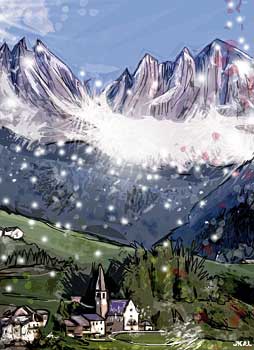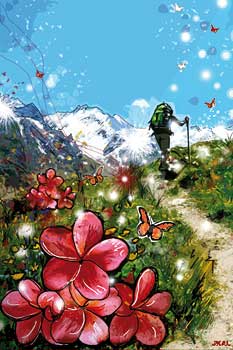| |

ELECTED REPRESENTATIVES FROM MOUNTAIN REGIONS
Mountaineering: an impoverished aristocrat?
Sonia Sbolzani
Images that roll by vertically along nature’s palette, the rapture of emptiness, the rarefied and hypnotic air, the scream of silence that is carried along on the wind, the sensual scent of nothing, the challenge posed to oneself and the game, that game that sometimes feels like a game of chess with death, reminiscent of the one in Bergman’s film entitled “The seventh seal”…
 This is the world of climbing and its frontiers, which are constantly expanding, like the universe, sometimes even beyond morals. But what is climbing nowadays? A trend? A sport? The utmost expression of mountaineering? This is the world of climbing and its frontiers, which are constantly expanding, like the universe, sometimes even beyond morals. But what is climbing nowadays? A trend? A sport? The utmost expression of mountaineering?
Rheinold Messner, the famous champion of the Himalayan “eight thousanders” actually defined the climber as “an artist who needs no justifications”.
Nowadays, especially in Italy, where the Dolomites have been the non plus ultra for rock climbers since the 1940’s, little remains of that “heroic” spirit that first experienced its deification during the Great War, then under the Fascist regime, and later during the Second World War (during the phenomenon of the Resistance in particular), only to then culminate in the conquering of the mythical K2 in 1954, thanks to the expedition guided by Ardito Desio. The beginning of the end dates back to the second half of the 1960’s and was marked by a process of slow and inexorable decline, which even led to the eclipse of the great names of National mountaineering, such as Walter Bonatti, the Duca degli Abruzzi, Vittoria Sella, Cichìn Ravelli, Riccardo Cassin, to mention but a few (and thus wronging many others, who have by now become anachronistic).
 Nowadays people prefer to climb artificial walls (mountains themselves, therefore have become an optional), perhaps with expansion bolts that remedy every fall and eliminate the risk of any adventurous uncertainty. And so even the limits of the sixth grade can be overcome, attaining even the ninth and beyond, thresholds that are more and more difficult, but in reality quite “flat”. Nowadays people prefer to climb artificial walls (mountains themselves, therefore have become an optional), perhaps with expansion bolts that remedy every fall and eliminate the risk of any adventurous uncertainty. And so even the limits of the sixth grade can be overcome, attaining even the ninth and beyond, thresholds that are more and more difficult, but in reality quite “flat”.
A sport like any other: perhaps this is what mountaineering is today. After all, this concept was well sensed in 1871, by Leslie Stephen (father of the famous writer Virginia Woolf), in his book “The Playground of Europe”, he described mountaineering as “a sport like cricket or canoeing, or any other”.
In short, this is the era of mere technical difficulty, with the ban of every risk that is not the typical risk of a metropolitan training gym. Those seeking the thrill of extreme danger engage in bungee jumping rather than venturing out with a rope and a mountaineering axe, or canyoning, acrobatic skiing or kite skiing. Or quite simply, they sit behind the wheel of a high-powered vehicle…
Perhaps only the memory and the inspiring paradigm of the ascesis still lives on, the scientific mission, the heroic adventure that once characterised the mountaineering of yesteryear. Perhaps only in some nostalgic or “purist” soul from the Italian Alpine Club (the Caai [Club Alpino Accademico Italiano] in particular, the league of excellence that represents the Academy of the group), which courageously ensures that the noble values of authentic, original and legitimate mountaineering live on, brimming with culture and history and with an elitist spirit.
Recognising the unattainable superiority of the few “elected representatives from mountain regions”, the well-known writer Dino Buzzati, who was known to have harboured a burning lifelong love for the Dolomites,  once wrote: “Now I understand how the great mountain revealed its most jealously guarded and powerful secrets to them alone. And not to poor fools like me, who felt afraid” (from the story entitled “I fuorilegge” published in 1963, in the celebratory volume created to mark the 100th anniversary of the CAI). once wrote: “Now I understand how the great mountain revealed its most jealously guarded and powerful secrets to them alone. And not to poor fools like me, who felt afraid” (from the story entitled “I fuorilegge” published in 1963, in the celebratory volume created to mark the 100th anniversary of the CAI).
ODE OF THE MOUNTAIN WALKER
Alongside mountaineers, mountain walkers also belong to the category of lovers of uncontaminated nature and solitude, who prefer the horizontal dimension to the vertical dimension of the mountains. In the name of freedom, as well as out of love for the environment. In fact, having donned his walking shoes, the walker can set out on his walk even the weather isn’t the best (it is sufficient to have a practical umbrella to hand), he needn’t bring any heavy backpacks (a sandwich, a piece of fruit and a wind breaker should suffice), he needn’t get up early or engage in any extenuating preparations, he can choose his itinerary as he pleases, he can walk at the pace that he chooses and return whenever he fancies, safe and at peace. And perhaps he might even meet someone on the trails, exchanging some courtesies with those whom he encounters.
But the greatest privilege of the mountain walker is that he has all the means and all the time he needs to look around, to enjoy the sublime landscapes and savour the enchantment of the high altitudes at his own pleasure.
J. Kalvellido illustrations |
|

 This is the world of climbing and its frontiers, which are constantly expanding, like the universe, sometimes even beyond morals. But what is climbing nowadays? A trend? A sport? The utmost expression of mountaineering?
This is the world of climbing and its frontiers, which are constantly expanding, like the universe, sometimes even beyond morals. But what is climbing nowadays? A trend? A sport? The utmost expression of mountaineering? Nowadays people prefer to climb artificial walls (mountains themselves, therefore have become an optional), perhaps with expansion bolts that remedy every fall and eliminate the risk of any adventurous uncertainty. And so even the limits of the sixth grade can be overcome, attaining even the ninth and beyond, thresholds that are more and more difficult, but in reality quite “flat”.
Nowadays people prefer to climb artificial walls (mountains themselves, therefore have become an optional), perhaps with expansion bolts that remedy every fall and eliminate the risk of any adventurous uncertainty. And so even the limits of the sixth grade can be overcome, attaining even the ninth and beyond, thresholds that are more and more difficult, but in reality quite “flat”. once wrote: “Now I understand how the great mountain revealed its most jealously guarded and powerful secrets to them alone. And not to poor fools like me, who felt afraid” (from the story entitled “I fuorilegge” published in 1963, in the celebratory volume created to mark the 100th anniversary of the CAI).
once wrote: “Now I understand how the great mountain revealed its most jealously guarded and powerful secrets to them alone. And not to poor fools like me, who felt afraid” (from the story entitled “I fuorilegge” published in 1963, in the celebratory volume created to mark the 100th anniversary of the CAI).